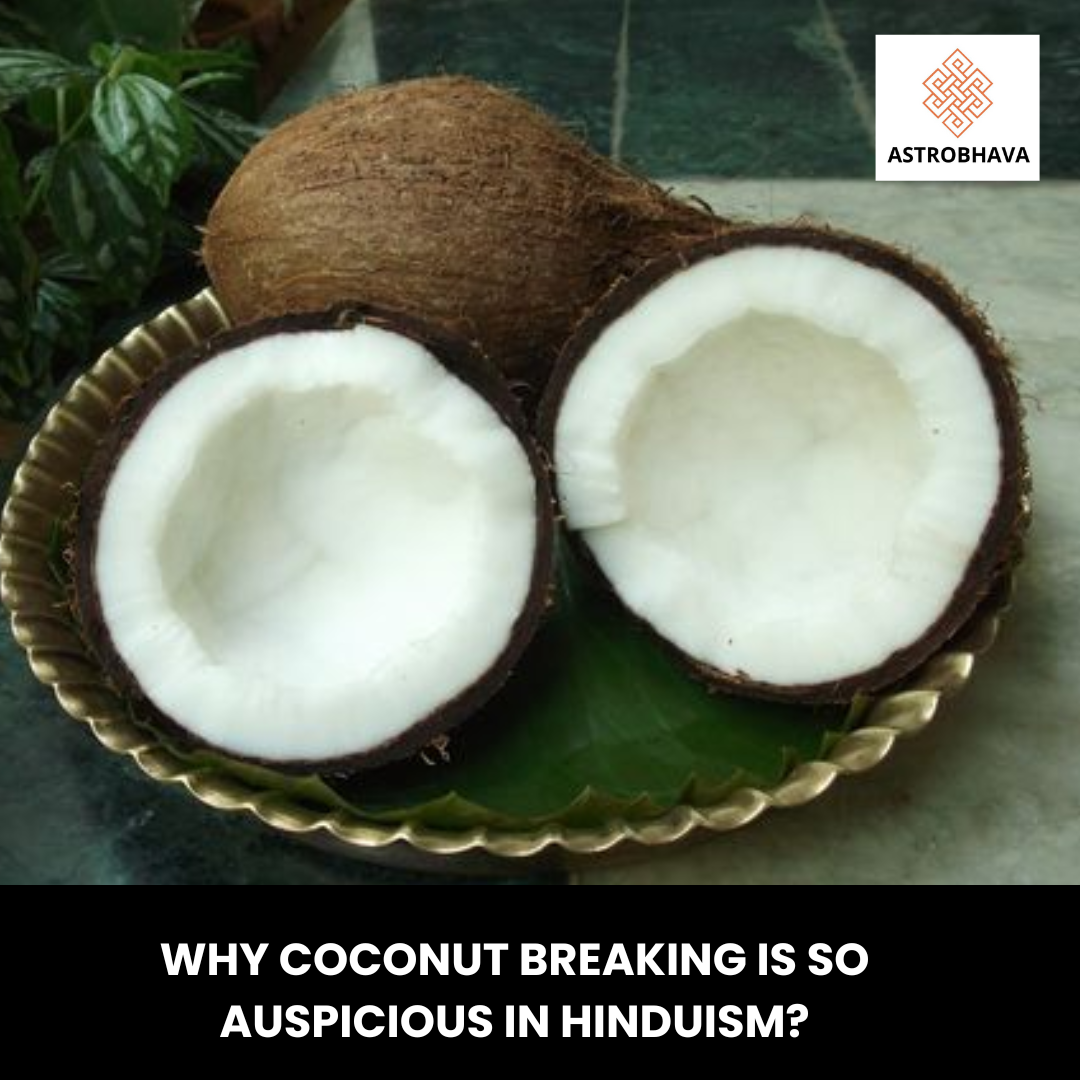3 Reasons Why Coconut Breaking is So Auspicious in Hinduism

In the vast expanse of Hindu rituals, coconut breaking holds a unique and powerful place. You’ve probably seen it—whether at temples, weddings, housewarming ceremonies, or even vehicle pujas—devotees performing the simple yet deeply symbolic act of coconut smashing. While it might look like a ritualistic offering, it actually carries profound spiritual, psychological, and cultural significance.
This blog explores the reasons why coconut breaking is so auspicious in Hinduism, along with its symbolism, ritual procedure, hidden meanings, and frequently asked questions.
Historical and Mythological Roots of Coconut Breaking
The practice of offering coconuts to deities dates back thousands of years. In Vedic times, animal sacrifices were common, but as spiritual practices evolved, symbolic offerings replaced them. The coconut, with its purity and life-giving qualities, became the perfect substitute. It’s believed that coconuts were first used in place of animal heads, symbolizing a bloodless sacrifice that maintains the sacred energy of the ritual.
Many Puranas and ancient scriptures mention the use of nariyal (coconut) in yagnas and homas. Lord Vishnu is often associated with the Kalpavriksha—the divine coconut tree that grants boons. This association further enhances its relevance in Hindu rituals.
“Facing Repeated Obstacles and Delays? Smash through your problems – literally and spiritually – by offering coconuts to Lord Ganesha. Each break is a prayer for removing hurdles and clearing the path forward.”
The Deeper Symbolism of Coconut Breaking
1. Breaking the Ego
One of the most spiritual interpretations of coconut breaking is that it symbolizes the shattering of the ego. The hard shell of the coconut represents the human ego—stiff, resistant, and difficult to penetrate. By breaking the coconut, a devotee symbolically smashes his or her ego, revealing the pure and divine essence within.
This act of ego-surrender is crucial in Hindu philosophy, which teaches that spiritual progress can only begin once the ego is humbled.
2. Three Eyes of the Coconut
The coconut has three visible dark “eyes” on one end, which are said to represent the three eyes of Lord Shiva—past, present, and future—or the three gunas (qualities): sattva, rajas, and tamas. Offering a coconut is symbolic of offering oneself in totality—body, mind, and soul.
3. Symbol of Fertility and Prosperity
Coconuts contain water and a soft, nourishing kernel—both symbols of fertility, abundance, and life. Hence, they are often used in weddings and housewarmings to invoke prosperity and continuity.
Significance of Breaking a Coconut in Rituals
The significance of breaking a coconut in rituals can be understood from both a spiritual and energetic perspective:
🔹 Spiritual Offering to the Divine
When we break a coconut before a deity, it represents offering our mind and ego in its rawest form. We are saying, “Take my ego and give me peace, purity, and divine wisdom.”
🔹 Removing Obstacles
This is especially important in rituals associated with Lord Ganesha, the remover of obstacles. Coconut breaking is often the first step in a puja, believed to clear the way for success and positive energy.
🔹 Energy Release and Transformation
From a yogic and energetic viewpoint, the sudden burst of energy that happens when a coconut is smashed sends out vibrational frequencies believed to dispel negative energies.
“Feeling Spiritually Weakened or Mentally Disturbed? Daily or weekly chanting of Skanda Puja brings strength, mental clarity, and divine protection—especially in times of fear, confusion, or spiritual dullness.”
How to Break Nariyal: Ritual Process and Vedic Procedure
Performing the act of coconut breaking correctly is vital. Here’s a detailed guide on how to break nariyal in a sacred way:
Step-by-Step Ritual:
- Select the Right Coconut: Choose a clean, fresh coconut with intact shell and water inside.
- Sanctify the Coconut:
- Wash it thoroughly.
- Apply haldi (turmeric), kumkum (vermilion), and sometimes sandalwood paste.
- Optional: wrap it in a red or yellow cloth.
- Offer to the Deity: Place it on the altar or before the idol, and chant relevant mantras (e.g., “Om Gan Ganapataye Namaha”).
- Break It with Devotion:
- Gently hit the coconut against a designated stone or hard surface.
- Try to break it in one clean shot.
- Ensure the water flows outward—this is considered auspicious.
- Offer and Distribute:
- The kernel is offered to the deity and later shared as prasad.
- Do not discard the shell disrespectfully; bury it or place it under sacred trees.
“Delays. Obstacles. Plans Not Moving Forward? Invoke the powerful grace of Arukumpal Vinayagar through this special Arukampal Ganapathi Homa. Break through hidden karmic blocks, dissolve negativity, and invite auspicious beginnings into your life.”
Coconut Smashing in Temples and Festivals
In many temples, especially in South India, devotees perform mass coconut smashing. At temples like:
- Palani Murugan Temple (Tamil Nadu)
- Siddhivinayak Temple (Mumbai)
- Mahalaxmi Temple (Kolhapur)
“Feeling Spiritually Disconnected or Lost? Reconnect with your inner self through a sacred Pilgrimage to the Arupadai Veedu – the six powerful abodes of Lord Muruga. Each temple addresses different life challenges and uplifts the soul.”
Devotees break hundreds or even thousands of coconuts to fulfill vows. This practice, known as “kudike” or “nariyal todna,” is a way of expressing gratitude or making a wish to the divine.
Example:
During Aadi Fridays or Thai Poosam in Tamil Nadu, you’ll see massive piles of coconuts being broken as an offering to Lord Murugan.
Coconut Breaking: Scientific and Psychological View
Even from a scientific or psychological point of view, coconut smashing has deeper meaning:
🔹 Stress Relief
The physical act of smashing something can be cathartic and symbolic. It allows devotees to release pent-up emotions and tensions.
🔹 Symbol of Life
The coconut water inside resembles amniotic fluid. Hence, the coconut is seen as a symbol of creation, life, and fertility.
🔹 Sound Vibration
The crack sound during the break sends out high-frequency sound waves that can influence the atmosphere positively.
“Struggling with Debts, Legal Issues, or Stagnation? Invoke the fierce energy of Karthaveeryarjuna through guided Japa sessions to gain victory, resolve karmic obstacles, and unlock financial movement.”
Coconut Breaking in Daily Life Rituals
This sacred act finds its way into many day-to-day Hindu rituals:
1. Before Starting a New Business or Project
Whether it’s launching a business, opening a shop, or initiating a creative venture, breaking a coconut marks the beginning of a prosperous journey. It is often done before turning on machines, opening shutters, or signing important contracts.
🔹 Purpose: Removes obstacles, invokes Lakshmi (goddess of wealth), and seeks blessings for success and sustainability.
2. Griha Pravesh (Housewarming Ceremony)
One of the most sacred domestic rituals in Hinduism is the Griha Pravesh or house-entering ceremony. The ritual begins with the smashing of a coconut at the entrance of the home, symbolizing the destruction of negative energy and the welcoming of positive vibrations.
🔹 Belief: The act ensures the new house is free from Vastu dosha and is sanctified for peaceful living.
3. Vehicle Puja
Before taking a new car or bike on its maiden journey, a small puja is performed where a coconut is broken under the vehicle’s front tire. This tradition is widely practiced across India.
🔹 Purpose: Offers protection against accidents, invokes Lord Ganesha’s blessings, and signifies a smooth, obstacle-free drive.
4. Weddings and Engagements
In both North and South Indian weddings, coconut breaking is part of multiple rituals—from engagement to mandap entry to reception. In Tamil weddings, for instance, a coconut is broken at the entrance before the bride and groom walk in.
🔹 Spiritual Meaning: It invokes fertility, purity, and the divine union of two souls.
5. Exams, Interviews, and Important Life Events
Students and job seekers often perform a small puja and break a coconut before going for exams or interviews. This is a heartfelt offering to Ganesha—the lord of wisdom and success.
🔹 Reason: It’s a symbolic prayer to remove anxiety, fear, and mental obstacles.
6. During Festivals and Religious Fasts
Festivals like Ganesh Chaturthi, Navratri, and Thai Pongal often begin with coconut offerings. Devotees break coconuts during vrats (fasts) and purnima rituals, as it is seen as an acceptable substitute for animal sacrifice in ancient times.
🔹 Custom: At the end of fasting rituals, coconut breaking marks the completion of the vow and offering of devotion.
7. Before Digging Land or Starting Construction (Bhoomi Puja)
Breaking a coconut is also a vital step during Bhoomi Puja, which is performed before laying the foundation for any building or structure.
🔹 Symbolism: The act pays respect to Mother Earth and seeks her permission and blessings for the construction.
8. Healing and Negative Energy Removal
In traditional Hindu households, especially in South India, coconuts are used during drishti removal (nazar dosh). The coconut is rotated around the person’s body and then smashed outside the house.
🔹 Purpose: To absorb and destroy negative energy, psychic disturbances, or spiritual blockages.
9. Temple Visits and Fulfillment of Vows (Mannat)
Many devotees break coconuts in temples after a wish is fulfilled. It’s a way to show gratitude and continue the connection with the deity.
🔹 Example: At Sabarimala Temple or Tirupati, it’s common to see heaps of broken coconuts—each one representing a fulfilled prayer or vow.
“New Beginnings Delayed? Projects Not Taking Off? Performing Ganapathi Homa invokes divine blessings for fresh starts, smooth ventures, and obstacle-free progress. Ideal before new jobs, housewarming, or any major move.”
Do’s and Don’ts in Coconut Breaking
DO:
- Use a fresh and unbroken coconut
- Apply traditional substances (kumkum, turmeric)
- Break it with a focused intention
- Dispose of remains respectfully (preferably under a tree)
DON’T:
- Break a spoiled or pre-cracked coconut
- Perform the ritual without prayer or intention
- Leave broken shells lying around
Final Thoughts
The ritual of coconut breaking is a beautiful blend of spiritual wisdom, symbolic depth, and devotional expression. Whether it’s to remove obstacles, honor deities, or mark new beginnings, this age-old practice remains as relevant today as it was centuries ago.
Through coconut smashing, we don’t just offer a fruit—we offer our pride, ego, and impurities to the divine, and in return, we receive grace, blessings, and positivity.
For more such spiritual insights, rituals, and Vedic wisdom, explore our resources at AstroBhava—your companion in divine discovery.
Frequently Asked Questions (FAQs)
Q1. Why is coconut breaking considered auspicious?
Coconut breaking is seen as an act of surrendering one’s ego and impurities to God. It symbolizes purity, new beginnings, and divine blessings.
Q2. Is there a specific deity to whom coconut is offered?
Yes, it is commonly offered to Lord Ganesha, Lord Shiva, Goddess Lakshmi, and Lord Murugan, depending on the ritual.
Q3. Can women perform coconut breaking?
Yes, women can perform this ritual, especially in personal pujas. However, in certain temples or regions, customs may vary.
Q4. What happens if a coconut doesn’t break cleanly?
It’s generally considered a sign to repeat the ritual with a new coconut. A clean break symbolizes successful offering and acceptance by the deity.
Q5. What is the spiritual meaning of coconut water spilling?
If coconut water spills outward while breaking, it’s a positive omen. If it spills inward or doesn’t spill at all, it may indicate the need for ritual repetition.
Categories
- accurate astrology readings
- Astrobhava
- Astrobhava astrology
- astrological guidance
- astrological planets
- Astrological Remedies
- astrology
- astrology basics
- Astrology Guides
- astrology remedies
- Astrology Remedies for Wellness
- astrology solutions
- birth chart analysis
- Career Astrology & Personal Growth
- Cosmology
- Dasha
- dosha
- Ekadashi rituals
- Ekadashi vrat
- Festivals & Vedic Rituals
- Homa and Fire Rituals (Yagna)
- horoscope remedies
- janma nakshatra effects
- Japa
- mahadasha effects
- Mahadasha remedies
- Mantra
- Mercury in astrology
- nadi astrology
- Nakshatra 2026 astrology
- nakshatras
- numerology
- Pilgrimage
- planetary remedies
- planets houses
- Progency
- Puja & Rituals
- Relationships
- rudra puja
- Rudraksha and gemstone
- shani remedies
- Spiritual Astrology
- Spiritual Practices and Chanting
- Spiritual Rituals and Personal Empowerment
- Spiritual Tools & Personal Growth
- Spiritual Wellness and Protection
- Spirituality and Rituals
- Spirituality or Vedic Rituals
- Vastu Tips
- Vedic Astrology
- yantras
- Zodiac Signs











